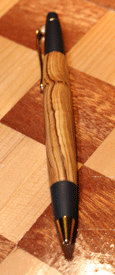Pen Making By Thomas Murphy
This blog is meant to showcase the art of Pen Making. It includes sections on why it is a good hobby as well as story pen made from Bethlehem Olivewood. Future articles will show steps to use to start making pens as well as pictures and stories about pens and small items made from various small pieces of exotic wood.
Monday, February 15, 2010
Why Make Pens?
Introduction to Pen Making
Pen making is putting a wood sleeve on a brass cylinder, shaping it to your desire and pressing all the pen components together. The components are bought but the wood doesn’t have to be. There is a wide variety of pen style kits available for making pens. For example a slim line pen kit includes all the components you need to make a pen except the wood. I.e. The pen tip, the ink refill, the brass cylinders the wood fits over, the pen clip and top piece, and the mechanism that advances the ink tip.
The first wood I used to make pens were little pieces of scrap hardwood from my wood box. I used Walnut from a discarded chair, some wood from an old hammer handle. Some poplar from some scrap piece, Red oak from an old shovel handle. And to get a little creative I used some plywood from an old discarded sewing machine. Plywood was different back then, the width of the layers more uniform.
After awhile of making these I bought some blanks of Cocobolo and some of Purple Heart wood. You will never see a greater variety of wood types than when you are looking at a pen making supply catalog. The grains are beautiful, and not too expensive for the little pieces that go into the pens. Cocobolo is said to be one of the most popular types to use. It is a dark brown wood with contrasting tiger like stripes. More recently I took advantage of a yearly sale and bought some exotic woods in an assortment package from woodturningz website.
Copyright 2010 Thomas Paul Murphy
Tuesday, February 9, 2010
Bethlehem Olivewood Pen




Bethlehem Olivewood
02/09/2010
The hand turned and made pen with 24kt Gold finished components is executive style, kit model # PKCEO . The wood of this pen is from the same trees that were around in the time of Jesus Christ. The certificate of authenticity tells me so.
The swerves and contrasting colors in the wood of this pen turned round from square stock, and finished to 1200 grit, are truly beautiful. But wait, as I look at this pen, more closely and sharpen my focus what do I see? I see the distinctive head of a bird. A painter could not have drawn a better rendition.
The body of the bird stands erect the length of the pen like that of a penguin, midway down it even has breasts. The bird has more pronounced hunch-like shoulders than a penguin. After the piercing eye is a sharp beak with a distinctive upper and lower part. At the lower part of the drapery of grain the feet have distinctive talons. With the scene made of wood I am almost led to use my imagination to call this a Woodpecker, however the ominous bird is pecking at an impermeable double layer of grain that reverberates a bend back at him but does not break or yield.
Turning the pen further clockwise I see what the bird is pecking at. The head of a baby bird with a distinctively pronounced baby bird beak not as sharp as the one on the left comes into focus. It too has a dot for an eye.
To the right of the baby bird’s beak I see a tiny seed. Wait a minute that second bird could be an octopus or dolphin if I hold this pen on its side. No I will settle for a seed because of the lack of graphic details to support the assertion of otherwise. The seed is much closer to the baby bird’s beak that the baby bird is to the ominous giant pecking bird, makes the meal of seed seem attainable to me.
As I turn further clockwise I see a giant sword the length of the wood of the pen revealed. The pen is mightier than the sword I think. Because of the religious link to the wood I am brought to the phrase, “Do not think I have come to send piece upon the earth; I have come to bring a sword, not piece.” Matthew 10:34
The wood is part of a small assortment of exotic wood pieces I bought from the yearly sale at Woodturningz.com and the bottom line is that I plan on making more these storied pens of Bethlehem Olivewood, because I have eight more pieces of wood to do so with and after which I might buy more. This essay is meant more to rekindle the imagination of adults and an interest in woodworking more than anything else. I know for a fact that I am the only one ever to see image formations in the clouds of the heavens or in the grain of wood and I consider this pen priceless.
COPYRIGHT 2010 THOMAS PAUL MURPHY